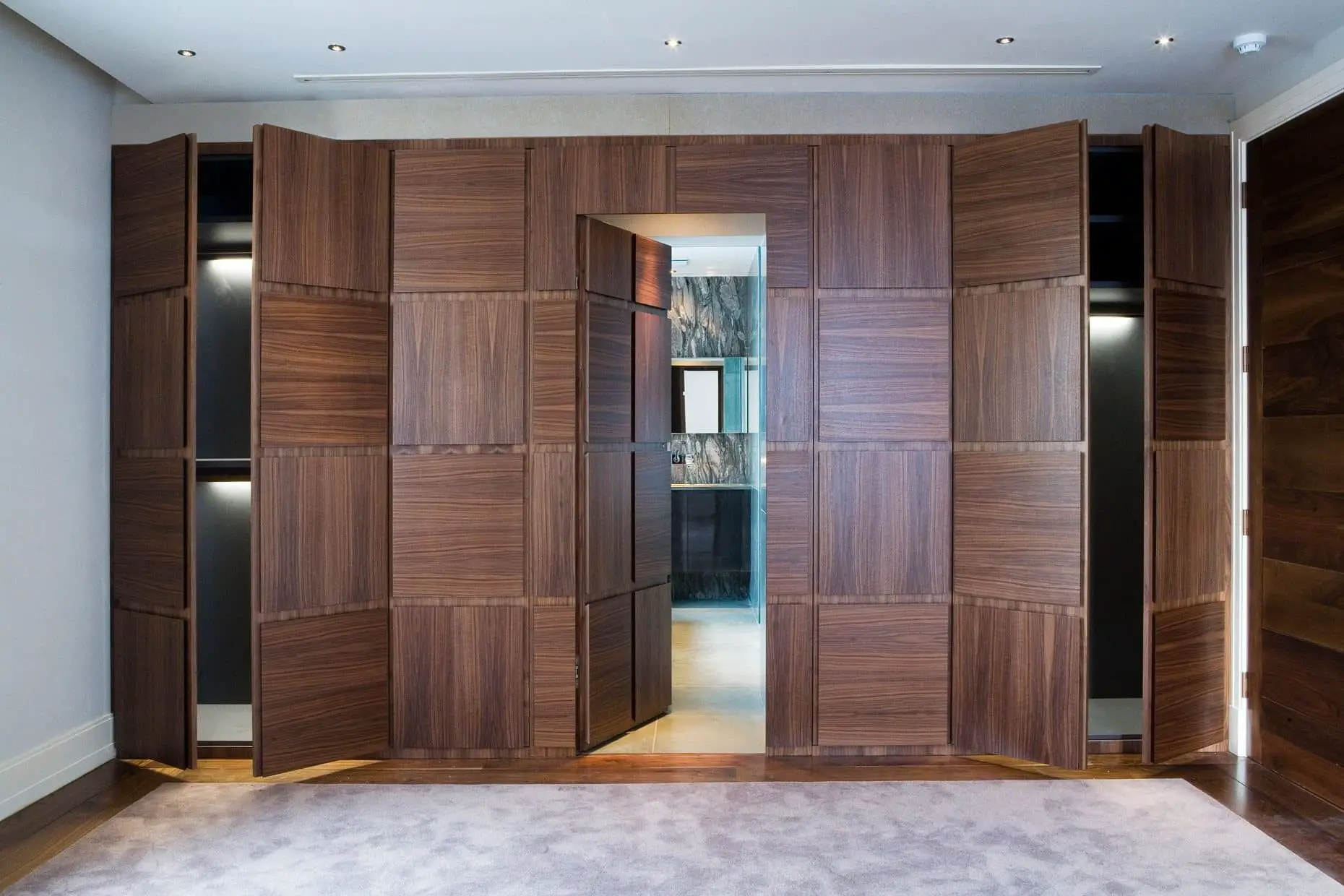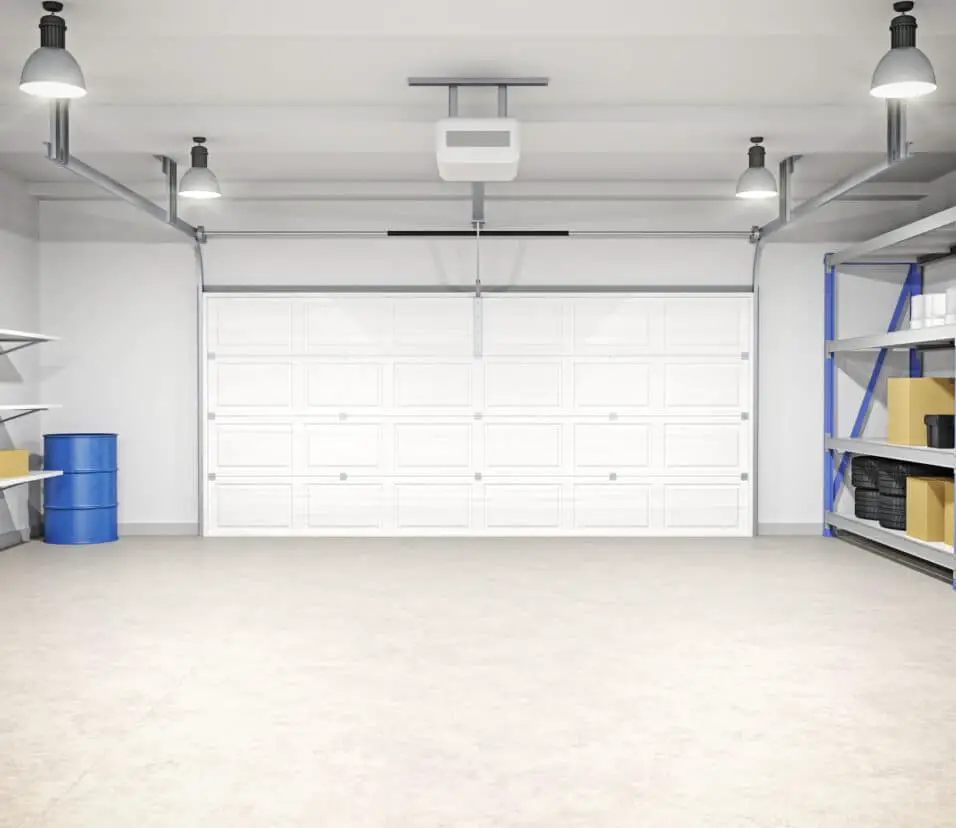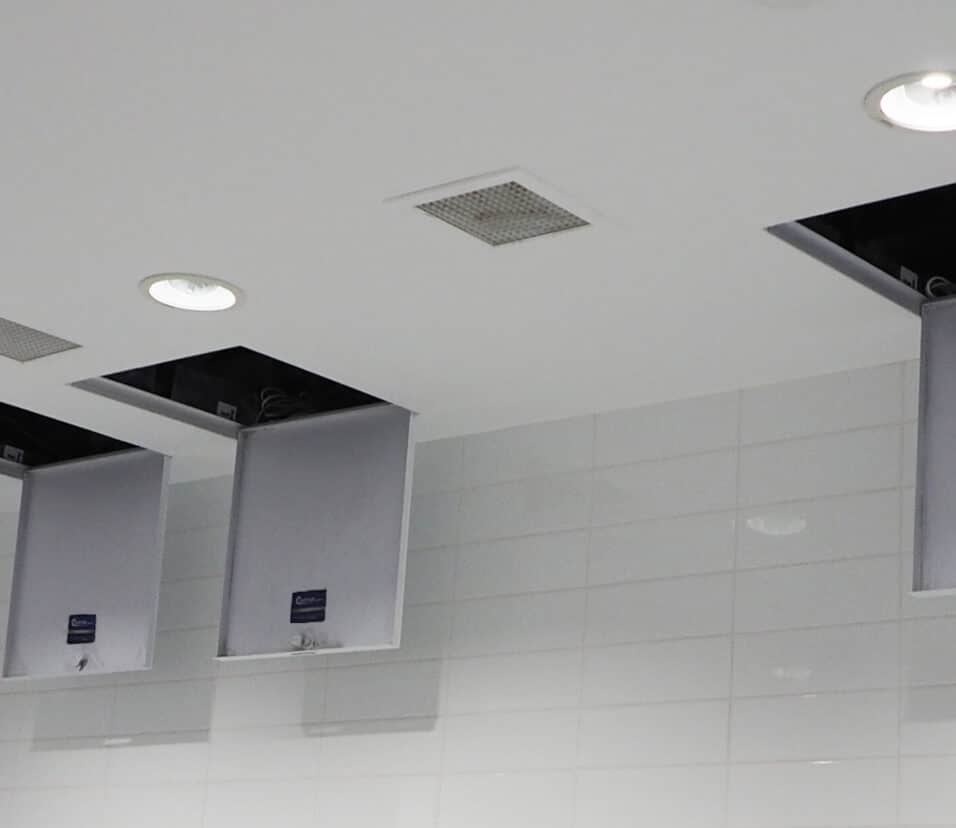How To Make A Hidden Door In Drywall
Introduction
Making a Hidden Drywall Door: Have you ever wanted a movie-style secret passage in your home? Lucky you! This post will show you how to make a drywall hidden door. This project will wow whether you want to add mystery to your home or hide a room or storage area.
Building a secret door may seem difficult, but with the correct equipment and time, it can be enjoyable and rewarding. It will give your home a unique look and start conversations with guests. Before we begin the step-by-step instructions, this project requires basic carpentry abilities and tools. If you’re not comfortable with power tools or accurate measurements, hire a pro.
You need a plan before starting. Consider the size of the opening, swing direction, and impediments when locating the hidden door. Consider the hidden door’s purpose and how it will fit into the design. Gather goods and tools after planning. Solid core doors, drywall panels, a circular saw, a drill, screws, hinges, a level, a tape measure, and a stud finder are needed. Safety gear like goggles and gloves is also helpful.
Next, measure and mark the dimensions of the hidden door on the drywall corner. Use a stud finder to locate the studs in the wall, as these will provide the necessary support for the door. Carefully cut out the opening using a circular saw, making sure to follow the marked lines precisely.
By following these instructions and taking the necessary precautions, you can create a hidden door in drywall that will add a touch of intrigue and excitement to your home. So, grab your tools and get ready to embark on this exciting DIY project!
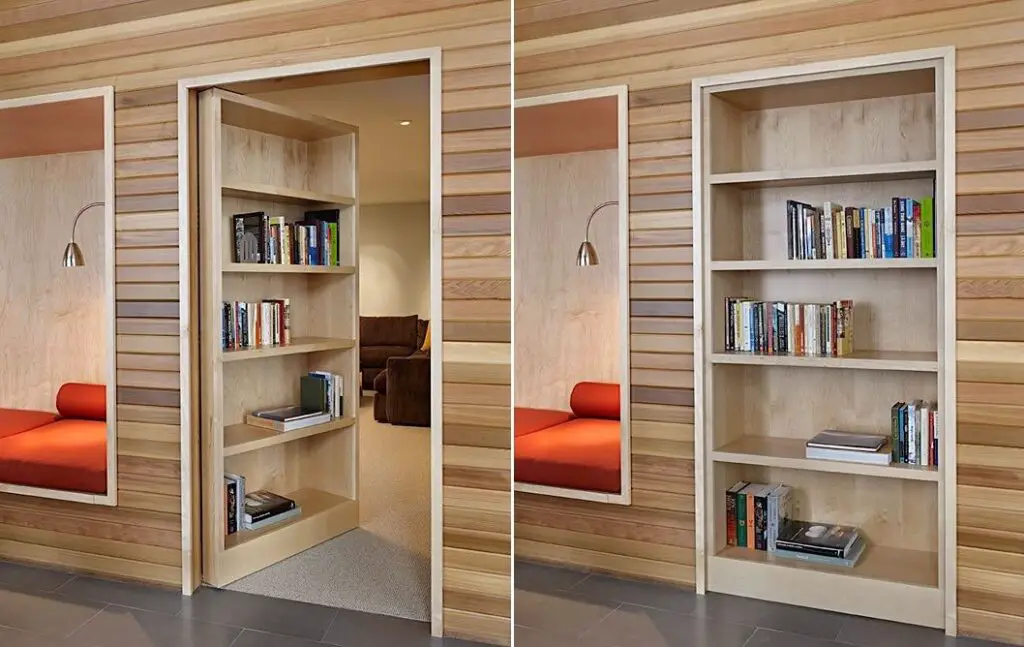
How do you make an invisible wall door?
Step 1: Planning and Design:
The first step in creating an invisible wall door is to carefully plan and design the layout. Consider the location where you want to install the door and assess the surrounding space. Take measurements and determine the dimensions of the door to ensure a proper fit.
Step 2: Materials and Tools:
Once you have a clear plan in mind, gather the necessary materials and tools for the project. You will need a sturdy door frame, hinges, screws, a latch or lock mechanism, and a suitable door material such as wood or metal. Additionally, you may require specialized equipment like a jigsaw, drill, and screwdriver to assemble and install the door.
Step 3: Construction:
Begin the construction process by assembling the door frame according to your measurements. Ensure that it is sturdy and securely attached to the surrounding wall. Next, attach the hinges to the frame and mount the door material onto the frame. Make sure the door fits snugly and opens smoothly. Install the latch or lock mechanism, ensuring it is hidden from view when the door is closed. Finally, test the door to ensure it functions properly and adjust any components if necessary.
Step 4: Finishing Touches:
Once the door is constructed and installed, it’s time to add the finishing touches. Conceal the door by painting it to match the surrounding wall or applying wallpaper or paneling. Consider adding decorative elements such as artwork or mirrors to further camouflage the door.
By following these steps and using your creativity, you can successfully create an invisible wall door that will undoubtedly impress and intrigue anyone who encounters it. Remember to take your time during the planning and construction process to ensure a seamless and functional end result. Enjoy the process and have fun with this unique home improvement project!
How do you make a door look like a hidden door?
Creating a hidden door can add an element of mystery and intrigue to any space. Whether you want to disguise a door as a bookshelf or make it blend seamlessly into a wall, there are several techniques you can use to achieve this effect. In this article, we will explore different methods and ideas on how to make a door look like a hidden door.
Method 1: Camouflaging with a Bookshelf:
One popular way to create a hidden door is by disguising it as a bookshelf. This technique works particularly well in libraries, home offices, or secret rooms. Start by selecting a door that matches the dimensions of a standard bookshelf. Install hinges on one side of the door and attach it to the wall. Next, construct a bookshelf around the door, making sure to leave enough space for the door to swing open. Paint the door and bookshelf in the same color to create a seamless appearance. Add real books to the shelves to enhance the illusion.
Method 2: Concealing with a Mirror:
Another clever way to make a door look like a hidden door is by using a mirror. This technique is ideal for bathrooms, bedrooms, or dressing rooms. Choose a full-length mirror that matches the style of the room. Attach hinges to one side of the mirror and mount it on the wall, covering the actual door. When the mirror is closed, it will appear as a regular mirror. To open the hidden door, simply push the mirror to the side. This method not only creates a hidden entrance but also adds functionality to the space.
Method 3: Blending into the Wall:
If you want to make a door completely disappear, consider blending it into the wall. This technique is commonly used in modern and minimalist designs. Start by selecting a door that matches the color and texture of the surrounding wall. Install the door using hidden hinges and recessed handles. Apply the same paint or wallpaper to the door and the adjacent wall, ensuring a seamless transition. When the door is closed, it will become virtually invisible, giving the impression of a hidden entrance. Creating a hidden door can be a fun and creative way to add a touch of mystery to your space.
How to build hidden slat door?
1: Measure your Space.
2: Install the Pre-Hung Flush Door in the Doorway.
3: Cutting the Wood Slat Wall Panels.
3.5: Cutting Holes for the Door Handle (Optional)
4: Fasten the Wood Slat Panels to Your Door.
5: Adding Slats Above the Door Frame.
6.5: Add Your Hardware (If Needed)
Materials and Tools:
Before diving into the construction process, it is essential to gather all the necessary materials and tools. You will need a solid core door, slats, hinges, a latch or lock mechanism, screws, a drill, a saw, sandpaper, wood glue, a tape measure, and a level. Additionally, you may want to consider paint or stain to match the door with its surroundings.
Step 1: Planning and Measurements:
Begin by carefully planning the location and dimensions of your hidden slat door. Measure the height and width of the doorway or opening where the door will be installed. Take into account any obstacles or obstructions that may affect the door’s functionality. It is crucial to ensure that the door fits perfectly and operates smoothly.
Step 2: Preparing the Door:
Once you have determined the measurements, it is time to prepare the door. If necessary, trim the door to the desired size using a saw. Sand the edges and surfaces of the door to create a smooth finish. If you wish to paint or stain the door, now is the time to do so. Allow the paint or stain to dry completely before proceeding to the next step.
Step 3: Installing the Slats:
Next, it is time to install the slats onto the door. Measure and mark the positions where the slats will be attached. Apply wood glue to the back of each slat and press them firmly onto the door. Use a level to ensure that the slats are straight and evenly spaced. Allow the glue to dry completely before moving on to the next step.
Step 4: Attaching Hinges and Lock Mechanism:
Once the slats are securely attached, it is time to install the hinges and lock mechanism. Position the hinges on the door and the door frame, ensuring that they are aligned. Secure the hinges with screws using a drill. Attach the latch or lock mechanism according to the manufacturer’s instructions. Test the door to ensure that it opens and closes smoothly.
What is a secret door called?
These doors are designed to blend seamlessly into their surroundings, often appearing as ordinary walls or bookshelves. However, behind their deceptive facade lies a hidden passage or room, creating an air of mystery and intrigue.
Historical Significance:
The concept of secret doors can be traced back to ancient times, where they were used for both practical and symbolic purposes. In ancient Egypt, for example, secret doors were incorporated into the design of tombs and temples to protect valuable treasures and sacred artifacts. These hidden entrances were meant to deter thieves and ensure the safety of the precious items within.
Architectural Marvels:
Secret doors have also been utilized in grand palaces and castles, showcasing the ingenuity and craftsmanship of architects and builders. During the Renaissance period, secret doors became popular in European palaces, such as the Palace of Versailles in France. These hidden passages were often used by royalty and nobility to move discreetly between rooms or escape in times of danger.
Modern Applications:
While secret doors may have originated from historical and architectural contexts, they continue to captivate our imagination in modern times. Today, secret doors are often incorporated into residential homes as a unique and whimsical feature. Homeowners may choose to install hidden doors leading to private studies, home theaters, or even panic rooms for added security.
Furthermore, secret doors have also found their place in popular culture, appearing in books, movies, and video games. These hidden passages often serve as plot devices, adding an element of surprise and adventure to the narrative. From the iconic hidden entrance to the Batcave in Batman comics to the magical Room of Requirement in the Harry Potter series, secret doors have become synonymous with mystery and discovery.
What is a wall pocket door?
A pocket door is the name used to describe a type of sliding door that recedes into the wall frame when it’s fully open. These doors are great for smaller spaces and tight areas when there isn’t enough room for a standard hinged door that swings open.
A wall pocket door is a type of door that slides into a recessed cavity within the wall, rather than swinging open and closed like a traditional hinged door. This innovative design allows the door to be completely hidden when open, creating a seamless and unobstructed transition between rooms. Wall pocket doors are commonly used in spaces where maximizing floor space and maintaining a clean aesthetic are important considerations.
One of the main advantages of a wall pocket door is its ability to save space. Unlike hinged doors that require clearance for opening and closing, pocket doors slide smoothly into the wall, freeing up valuable floor space. This makes them an ideal choice for smaller rooms or areas where space is limited. Additionally, pocket doors can be used to divide larger rooms into separate areas, providing flexibility in how the space is utilized.
providing flexibility in how the space is utilized
Another benefit of wall pocket doors is their ability to enhance the overall design and flow of a space. When closed, pocket doors create a seamless wall surface, allowing for uninterrupted wall treatments such as artwork or shelving. This can contribute to a more cohesive and visually appealing interior design. Furthermore, pocket doors can be customized to match the surrounding walls, blending seamlessly into the overall aesthetic of the room.
When it comes to creating a hidden door in drywall, there are several materials and tools that you will need to ensure a successful project. Firstly, you will require a solid core door, preferably one that matches the existing doors in your home. This will serve as the base for your hidden door. Additionally, you will need a piano hinge, which is a long hinge that runs the entire length of the door and provides stability and support.
Other essential materials include drywall screws, a stud finder, a level, a tape measure, a utility knife, and drywall compound. The drywall screws will be used to secure the door frame to the surrounding wall, while the stud finder will help you locate the studs for added support. The level and tape measure are crucial for ensuring that the door is installed straight and at the correct height. Lastly, the utility knife and drywall compound will be used to cut and patch the drywall, creating a seamless finish.
In summary, the necessary materials and tools for making a hidden door in drywall include:
- Solid core door
- Piano hinge
- Drywall screws
- Stud finder
- Level
- Tape measure
- Utility knife
- Drywall compound
By having these materials and tools ready, you will be well-equipped to embark on your hidden door project and create a seamless and functional addition to your home.
What are the step-by-step instructions for creating a hidden door in drywall?
Creating a hidden door in drywall can be a fun and exciting project that adds a touch of mystery to your space. Here are the step-by-step instructions to guide you through the process:
Planning and Design: Start by determining the location and size of your hidden door. Consider factors such as the surrounding walls, furniture placement, and the purpose of the hidden door. Sketch out a design and take measurements to ensure a proper fit.
Gather Materials and Tools: You will need a variety of materials and tools for this project. Some essential items include a solid core door, drywall panels, hinges, screws, a circular saw, a drill, a level, a tape measure, and a utility knife.
Prepare the Opening: Once you have gathered all the necessary materials, mark the outline of the hidden door on the drywall. Use a utility knife to carefully cut along the marked lines and remove the drywall to create the opening. Be cautious not to damage any electrical or plumbing lines that may be hidden behind the wall.
Install the Door: Attach the hinges to the solid core door instructions.
Then, position the door within the opening and secure the hinges to the surrounding drywall. Use a level to ensure the door is properly aligned and adjust as needed.
Conceal the Door: To make the door blend seamlessly with the surrounding wall, attach drywall panels to the exposed sides of the door. Use screws to secure the panels in place and ensure they are flush with the existing wall. Apply joint compound to the seams and sand it down for a smooth finish.
Finishing Touches: Once the joint compound is dry, paint the entire wall, including the hidden door, to match the surrounding area. Consider adding trim or molding to further conceal the door and enhance its appearance.
By following these step-by-step instructions, you can successfully create a hidden door in drywall and add an element of intrigue to your space.
Are there any specific measurements or dimensions that need to be considered when making a hidden door in drywall?
When creating a hidden door in drywall, it is crucial to consider specific measurements and dimensions to ensure a proper fit and functionality. The first step is to determine the desired size and location of the hidden door. Measure the height, width, and depth of the space where the door will be installed. Take into account any obstructions such as electrical outlets, light switches, or plumbing fixtures that may affect the dimensions.
Next, it is important to consider the thickness of the drywall. Standard drywall thickness is typically 1/2 inch or 5/8 inch. Measure the thickness of the existing drywall to ensure the hidden door will align seamlessly with the surrounding wall. Additionally, consider the weight-bearing capacity of the hidden door. If the door is intended to support any weight, such as a bookshelf or storage unit, it is essential to reinforce the structure with appropriate framing and supports.
Overall, precise measurements and dimensions are crucial for a successful hidden door installation. Taking the time to accurately measure the space, drywall thickness, and weight-bearing requirements will ensure a seamless integration of the hidden door into the existing drywall.
Are there any safety precautions or considerations to keep in mind while constructing a hidden door in drywall?
When constructing a hidden door in drywall, it is crucial to prioritize safety and take certain precautions to ensure a successful and secure installation. Here are some important safety considerations to keep in mind:
Structural Integrity: Before starting the project, it is essential to assess the structural integrity of the wall where the hidden door will be installed. Ensure that the wall can support the weight of the door and any additional mechanisms or hardware that may be involved. Reinforcing the wall with additional studs or supports may be necessary.
Electrical Wiring: Take extra caution to avoid damaging any electrical wiring that may be present within the wall. Before cutting into the drywall, it is advisable to turn off the power supply to the area and use a stud finder or other tools to locate and avoid any electrical wires. If necessary, consult a professional electrician to ensure the safety of the wiring.
Proper Tools and Equipment: Use the appropriate tools and equipment for the job to minimize the risk of accidents or injuries. This may include a utility knife, drywall saw, measuring tape, level, drill, screws, and other necessary hardware. Ensure that all tools are in good working condition and follow the manufacturer’s instructions for safe usage.
Personal Protective Equipment (PPE): Wear appropriate personal protective equipment, such as safety goggles, gloves, and a dust mask, to protect yourself from potential hazards. Cutting into drywall can create dust and debris, so it is important to take precautions to prevent inhalation or skin irritation.
By considering these safety precautions and taking the necessary steps to ensure a secure installation, you can create a hidden door in drywall with confidence and peace of mind.
Are there any alternative methods or techniques for creating a hidden door in drywall that may be easier or more efficient?
When it comes to creating a hidden door in drywall, there are indeed alternative methods and techniques that can make the process easier and more efficient. One such method is using a pre-made hidden door kit. These kits typically come with all the necessary materials and hardware, making it a convenient option for those who may not have extensive carpentry skills or access to specialized tools. These kits often include a pre-hung door, hinges, and a mechanism for the door to swing open and close smoothly.
Another alternative method is utilizing bookcase doors. This involves converting a regular bookcase into a hidden door by attaching it to a swinging mechanism. Bookcase doors can be a great option for those who want a hidden door that seamlessly blends in with the surrounding decor. They can be customized to match the style of the room and can provide a unique and functional design element.
Additionally, there are companies that specialize in creating custom hidden doors. These companies can design and build hidden doors tailored to specific measurements and requirements. While this option may be more expensive, it offers the advantage of professional expertise and a high-quality finished product.
If you’re looking for alternative methods or techniques for creating a hidden door in drywall, consider using pre-made hidden door kits, converting a bookcase into a hidden door, or seeking the services of a custom hidden door company. These options can make the process easier, more efficient, and provide a hidden door that suits your specific needs and preferences.
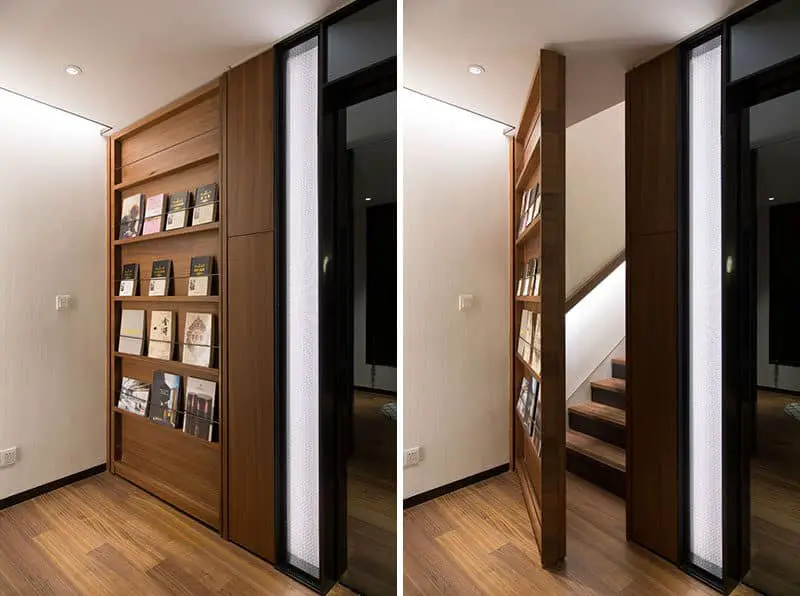
Conclusion
Creating a hidden door in drywall can be a fascinating and practical project for those looking to add a touch of mystery and functionality to their living spaces. By following the instructions provided, individuals can successfully design and construct a hidden door that seamlessly blends into the surrounding drywall, creating a seamless and inconspicuous appearance.
One of the key advantages of a hidden door in drywall is the element of surprise it brings to any room. Whether it’s a secret passage leading to a hidden room or a concealed storage space, these doors can add an exciting and unexpected twist to the overall design of a home. Additionally, hidden doors can also serve as a clever solution for maximizing space in smaller areas, as they can be seamlessly integrated into the existing walls without taking up any additional floor space.
Creating a hidden door in drywall can be a rewarding and exciting project that adds both functionality and intrigue to any living space. By carefully following the instructions and considering safety measures, individuals can successfully design and construct a hidden door that seamlessly blends into the surrounding drywall, creating a seamless and inconspicuous appearance. So, why not embark on this creative endeavor and unlock the hidden potential of your home



